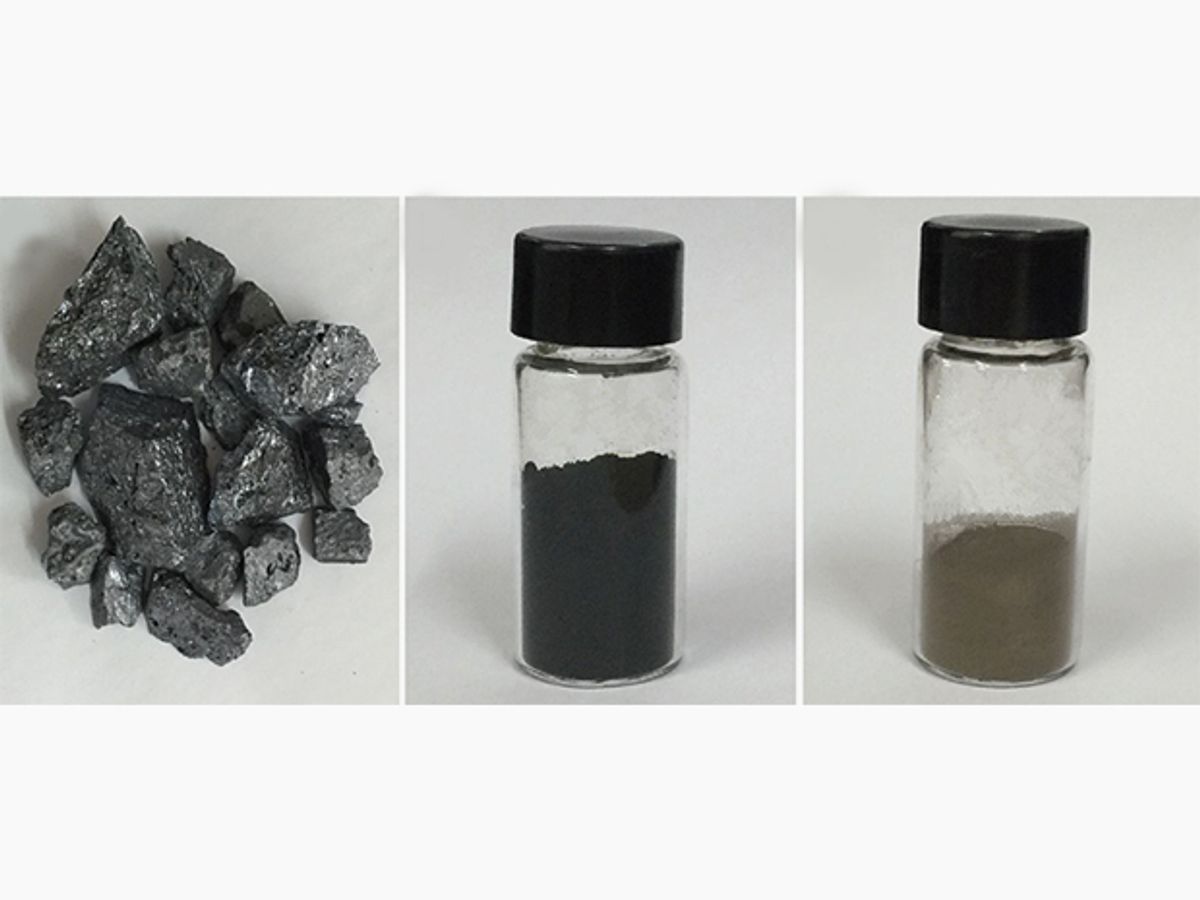Silicon is the second most abundant element on earth. Unfortunately, it’s mostly found in impure forms, not the refined elemental stuff needed for integrated circuits and solar cells.
The existing technology for making pure silicon is mature but it’s expensive and dirty, and it’s optimized for making electronics—not battery electrodes, thermoelectrics, and solar cells, which have different requirements, says Nanjing University’s Jia Zhu. He worked with Yi Cui, a materials scientist at Stanford University, to develop a simple and cheap nanotech trick to get 99.999 percent pure silicon from cheap bulk ferrosilicon.
First they grind bulk ferrosilicon in a ball mill, down to particles smaller than 100 nanometers. Inside the grinder, the material tends to break at points where there are impurities, which are now exposed on the huge surface area of the nanoparticles. A quick dip in a mix of strong acids strips away oxygen and metal impurities, converting the material from 84 percent silicon by weight to 99.999 percent.
This process is a throwback to WWII-era methods for silicon purification, but with a nano twist. Acid etching of silicon has been around since at least 1919, and during the Second World War metallurgical silicon was crushed and etched to make radar components. But this crush-and-etch method never achieved high purity, because no one had focused on getting the particles down to nano size. So an energy-intensive, expensive process that leads to very high purity became standard. The Siemens method uses temperatures of over 1000° C, to purify and deposit pure silicon from gases. It can produce very high purities, including the 99.9999999 percent pure silicon needed for today’s integrated circuits.
Zhu and Cui’s method can’t achieve those kinds of numbers, but 99.999 percent is good enough to make thermoelectric devices and battery electrodes with. In their 19 October paper on the nanopurification process in the Proceedings of the National Academy of Sciences, the researchers show they can make an anode for a working battery with their cheaper silicon. Silicon anodes are a big area of research in Cui’s lab and the core technology of the company he founded, Amprius.
The costs vary depending on the specific application, but Zhu and Cui believe their process could save a lot of money. Bulk ferrosilicon costs about US $1 per kilogram, and their process for making silicon that’s 99.999 percent pure, or “five nines”, shouldn’t add substantially to that.
Silicon for solar cells typically has to be six nines and costs $50 to $100/kg, says Zhu. The group is in striking distance of six nines, but he says it may not be necessary to get there. He’s working on making five-nines silicon solar cells that uses new light trapping designs. He also notes that most of the remaining impurities are boron and phosphorus, the elements used for the p- and n-type doping that give silicon its bandgap. So if he can figure out how to remove one or the other at a time, the cheap silicon may come pre-doped.
A recent study of capital costs for building new solar factories suggests that bringing down the cost of purifying silicon could make a difference in the solar market. In an analysis published in Energy & Environmental Sciencein September, researchers at MIT and the National Renewable Energy Laboratory worry that the capital expense of opening new PV factories could slow the growth of the solar industry. Tonio Buonassisi and his colleagues pin a large chunk of that capital expense on the materials: 45 percent of total capital expense in opening a new solar factory goes to the equipment and facilities needed to purify silicon and grow it into crystalline hunks. And 17 percent of the total capital expense comes from the purification method Zhu wants to replace, the high temperature Siemens purification process.
Buonassisi and crew write that due to high capital costs, the current growth rate of the solar industry, about 50 percent annually, is not sustainable; something more like 19 percent per year is more realistic. Disruptive technology’s like Zhu’s could help, down the line. “Silicon is so abundant and the processes are so mature, but we can still make it cheaper,” says Zhu.
Katherine Bourzac is a freelance journalist based in San Francisco, Calif. She writes about materials science, nanotechnology, energy, computing, and medicine—and about how all these fields overlap. Bourzac is a contributing editor at Technology Review and a contributor at Chemical & Engineering News; her work can also be found in Nature and Scientific American. She serves on the board of the Northern California chapter of the Society of Professional Journalists.



